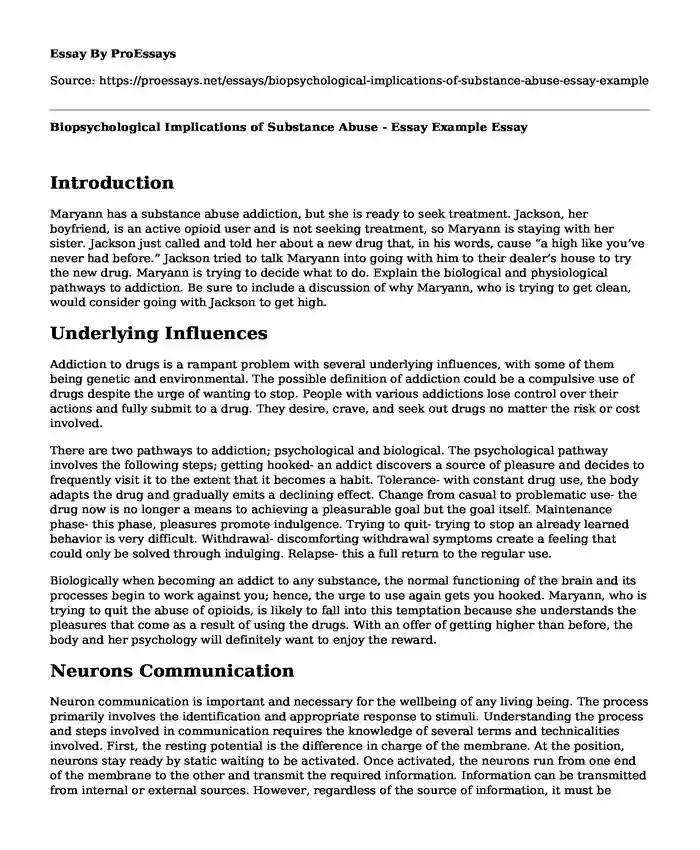Introduction
Maryann has a substance abuse addiction, but she is ready to seek treatment. Jackson, her boyfriend, is an active opioid user and is not seeking treatment, so Maryann is staying with her sister. Jackson just called and told her about a new drug that, in his words, cause “a high like you’ve never had before.” Jackson tried to talk Maryann into going with him to their dealer’s house to try the new drug. Maryann is trying to decide what to do. Explain the biological and physiological pathways to addiction. Be sure to include a discussion of why Maryann, who is trying to get clean, would consider going with Jackson to get high.
Underlying Influences
Addiction to drugs is a rampant problem with several underlying influences, with some of them being genetic and environmental. The possible definition of addiction could be a compulsive use of drugs despite the urge of wanting to stop. People with various addictions lose control over their actions and fully submit to a drug. They desire, crave, and seek out drugs no matter the risk or cost involved.
There are two pathways to addiction; psychological and biological. The psychological pathway involves the following steps; getting hooked- an addict discovers a source of pleasure and decides to frequently visit it to the extent that it becomes a habit. Tolerance- with constant drug use, the body adapts the drug and gradually emits a declining effect. Change from casual to problematic use- the drug now is no longer a means to achieving a pleasurable goal but the goal itself. Maintenance phase- this phase, pleasures promote indulgence. Trying to quit- trying to stop an already learned behavior is very difficult. Withdrawal- discomforting withdrawal symptoms create a feeling that could only be solved through indulging. Relapse- this a full return to the regular use.
Biologically when becoming an addict to any substance, the normal functioning of the brain and its processes begin to work against you; hence, the urge to use again gets you hooked. Maryann, who is trying to quit the abuse of opioids, is likely to fall into this temptation because she understands the pleasures that come as a result of using the drugs. With an offer of getting higher than before, the body and her psychology will definitely want to enjoy the reward.
Neurons Communication
Neuron communication is important and necessary for the wellbeing of any living being. The process primarily involves the identification and appropriate response to stimuli. Understanding the process and steps involved in communication requires the knowledge of several terms and technicalities involved. First, the resting potential is the difference in charge of the membrane. At the position, neurons stay ready by static waiting to be activated. Once activated, the neurons run from one end of the membrane to the other and transmit the required information. Information can be transmitted from internal or external sources. However, regardless of the source of information, it must be passed through several steps. Also, it must be received, transmitted to the central nervous system, transmitted to muscles, and further processed to produce the expected response or action.
The first step involves the reception of signals. The step is primarily concerned with the detection of signals and stimuli by various sensory organs, for example, eyes and skin. After signals are received, they are transmitted to relevant muscles or glands through the transfer of the signal from one neuron to another. The signal is then sought and interpreted to facilitate the processing of relevant responses. Finally, the expected response is given or applied, and the neurons are waiting for the next signal.
Ecstasy, which is mostly used as a recreational drug, has several effects on neuron communication and related processes. The drug has been seen to have negative effects on axons transmitters’ availability leading to erosion of binding potential. However, abstinence has been seen to help with the recovery and regeneration of binding abilities. The drug also reduces the efficiency of the system and increases an individual’s reliance on it to operate normally.
Conclusion
There exist two types or levels of stress amygdala anxiety and cortex anxiety. The two types are formed from the way the brain reacts to threats to an individual’s survival. The brain can react by activating the amygdala, which is a structure located in the mid-section of the brain. The structure facilitates fleeing or fighting response. It involves increased heart rate and accelerated breathing patterns. The brain can also engage the cortex in the reaction and therefore produce different results. The cortex allows for better analysis of situations and threats, therefore allowing an individual to react better and in a more organized manner.
Cite this page
Biopsychological Implications of Substance Abuse - Essay Example. (2023, Nov 25). Retrieved from https://proessays.net/essays/biopsychological-implications-of-substance-abuse-essay-example
If you are the original author of this essay and no longer wish to have it published on the ProEssays website, please click below to request its removal:
- Women, Marriage, Divorce and the Emerging Colonial State in Africa
- The Potential Support That the Client Needs in Family Breakdown
- Walking on Sunshine: A Rhetorical Analysis Paper Example
- My Avalanche of Kindness Essay Example
- Film Analysis Essay on "Farm to Fridge"
- Essay Sample on Marlon's Safety Threats: Physical Harm by Mother
- Essay Example on Femininity: From Suffrage to Popular Culture in the 1950s







